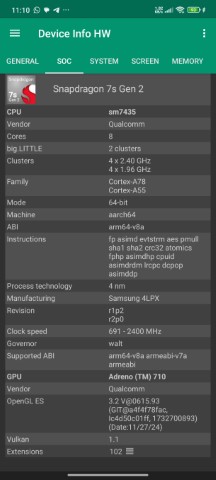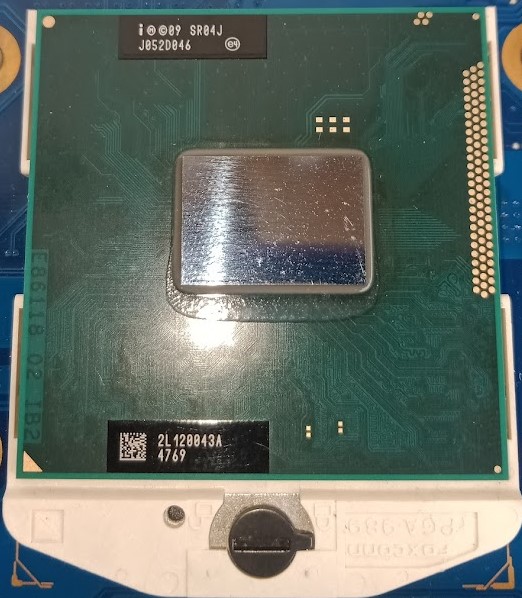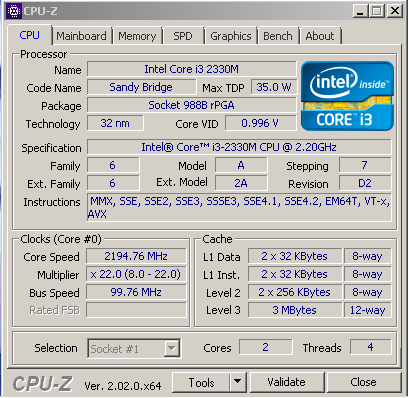Comparing: Intel Core i3 2330M vs Qualcomm SM7435-AB Snapdragon 7s Gen 2
In this comparison, we analyze two Processors: Intel Core i3 2330M and Qualcomm SM7435-AB Snapdragon 7s Gen 2, using synthetic benchmark tests to evaluate their overall performance. This side-by-side comparison helps users understand which hardware delivers better value, speed, and efficiency based on standardized testing. Whether you're building a new system or upgrading an existing one, this benchmark-driven evaluation offers valuable insights to guide your decision.

Qualcomm SM7435-AB Snapdragon 7s Gen 2
| Type: | Processors |
|---|---|
| Brand: | Qualcomm |
| Model: | Snapdragon 7s Gen 2 |
Specification Comparison Table
This specification comparison presents technical details of several devices or components to help you understand the key differences between each option. Use this table as a reference to determine which device best suits your needs.
| Specification | Intel Core i3 2330M | Qualcomm SM7435-AB Snapdragon 7s Gen 2 |
|---|---|---|
| Architecture | x86 | ARM |
| Technology | 32 nm | 4 nm |
| Clock | 2.2 GHz - - | 1.9 GHz - 2.4 GHz |
| Core/Thread | 2 / 4 | 8 / 8 |
| Segmen | Mobile | Mobile |
Submission Comparison Table
This submission comparison table displays the number and details of benchmark data submissions from various devices or components. This information helps you understand the performance based on the benchmarks that have been tested, as well as providing an overview of the consistency and popularity of the available benchmark results.
Submission Comparison Chart
This chart visualizes the benchmark scores comparison between two hardware devices based on submitted data.
Media Gallery
A collection of photos of tested hardware. These images can help you identify the physical form, model, and variant of the hardware in question. These photos are from our own documentation, and if they are not available we may not be able to document them.
About Hardware Intel Core i3 2330M
The Intel Core i3-2330M is a dual-core mobile processor launched in 2011 as part of Intel’s second-generation Sandy Bridge lineup. Designed for mid-range laptops, this processor features 2 cores and 4 threads thanks to Intel Hyper-Threading Technology, allowing it to handle light to moderate multitasking workloads efficiently. Operating at a fixed clock speed of 2.2 GHz and built on the 32nm process, the i3-2330M does not include Intel Turbo Boost, which limits its ability to dynamically increase performance under heavier loads, but it remains a solid choice for everyday use.
With a TDP of 35W, the i3-2330M balances power consumption and performance reasonably well for its era. It integrates Intel HD Graphics 3000, a GPU with a base clock of 650 MHz and a dynamic frequency up to 1.1 GHz. While not designed for modern gaming or demanding graphic applications, this integrated GPU handles HD video playback, basic 3D rendering, and older or lightweight games at low settings with relative ease. Users looking for casual computing and multimedia playback will find it sufficient.
In real-world usage, the Core i3-2330M performs well for standard computing tasks such as web browsing, streaming, office productivity (e.g., Word, Excel), and simple photo editing. Its Hyper-Threading capabilities give it a performance edge over older dual-core processors that lack thread duplication. However, the lack of Turbo Boost and a relatively low base frequency mean that it can struggle under CPU-intensive workloads like video rendering or large spreadsheet processing, especially when compared to more modern CPUs.
This specific configuration was tested on a SAMSUNG 300E4Z, a laptop originally shipped with an Intel Celeron B815 processor but later upgraded to the i3-2330M for better performance. With 4GB of DDR3 dual-channel memory and Windows 7 installed, the system runs smoothly for basic daily use, making the i3-2330M a practical upgrade option for budget-conscious users seeking improved performance without replacing their entire system.
Hardware Detail:
Device: SAMSUNG 300E4Z (This device originally used Celeron B815 which was upgraded to i3 2330M.)
RAM: 4GB DDR3 Dual Channel
OS: Windows 7
Friday, 05 February 2021 15:48:13 | Update: 1 month ago
About Hardware Qualcomm SM7435-AB Snapdragon 7s Gen 2
The Qualcomm Snapdragon 7s Gen 2 (SM7435-AB) is one of the latest System on Chip (SoC) solutions designed to deliver high performance in the mid-range segment without compromising on energy efficiency. Built using advanced 4nm fabrication technology, this chip offers an ideal balance between processing power, energy efficiency, and robust graphics capabilities. The Snapdragon 7s Gen 2 features an octa-core CPU configuration (8 cores/8 threads) operating at clock speeds ranging from 1.9GHz to 2.4GHz, enabling it to handle a variety of computational tasks, from light multitasking to casual gaming.
While details such as L3 cache and the official codename have not been widely disclosed, the chipset's performance is evident from benchmark results. In testing using the Xiaomi Redmi Note 13 Pro 5G running Xiaomi HyperOS 1 based on Android 14, the Snapdragon 7s Gen 2 achieved competitive scores in its class. In the AnTuTu v10 benchmark app, the CPU score reached 200,590 points, positioning it as one of the top choices in the mid-range segment. Meanwhile, in the Geekbench 6 synthetic performance test, the chipset achieved a score of 1,026 for single-core and 2,916 for multi-core, proving that this SoC can handle various modern applications smoothly.
For graphics, the Snapdragon 7s Gen 2 relies on the integrated Qualcomm Adreno 710 GPU, which is sufficiently capable for playing popular games at medium to high graphics settings. The chipset also uses a BGA (Ball Grid Array) socket design, a common standard for modern mobile devices, ensuring dense and efficient integration.
The test device uses 256GB UFS internal storage and 8GB RAM, ensuring no memory bottlenecks during benchmarking. All testing was conducted on a brand-new device, using the latest operating system and benchmarking applications, and after all system updates were applied.
Overall, the Snapdragon 7s Gen 2 is an excellent choice for users seeking a balance of performance, efficiency, and reliability in a mid-range device. With solid benchmark results and 4nm fabrication technology, this chipset is one of the most competitive options in the current 5G smartphone market.
Device Test (testbed):
Device: Xiaomi Redmi Note 13 Pro 5G
Specs: Snapdragon 7s Gen 2, 256GB UFS, 8GB RAM
OS: Xiaomi HyperOS 1 (Android 14)
* Testing device in new condition, latest benchmark software, and latest system updates
Wednesday, 09 July 2025 23:12:14 | Update: 6 days ago




